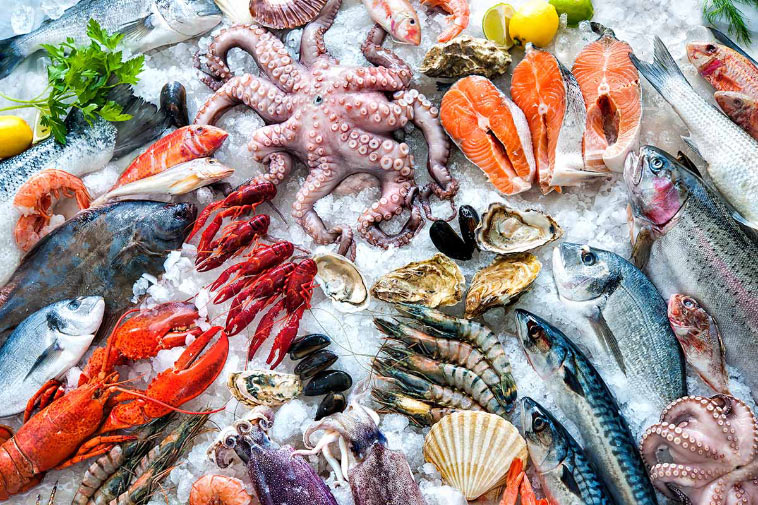“Rising global demand for seafood, driven mainly by a rapidly-growing middle class in China and other Asian nations, is putting new pressure on the aquaculture industry to find sustainable ways to increase productivity.”
~Global Aquaculture Alliance, October 2010, Kuala Lumpur, Malaysia
As goes Asia, so goes the rest of the world, especially when it comes to seafood. The nation of China is the number-one processor, producer, exporter, and importer of aquacultural products in the world. However, the region of Southeast Asia is the number-two global supplier of fish and projected to be the second-greatest consumer of seafood by the year 2030.
Currently, Southeast Asia supplies approximately 18 billion kilos of fish every year. To fully envision what this means, think of this – right now Southeast Asia supplies more of the world’s fish than North America, India, Japan, and the Middle East/North Africa regions combined, and that number is supposed to increase by 45% within the next 15 years
According to the National Oceanic and Atmospheric Administration, the average citizen of Asia consumes 40 kilos of seafood per year, and to put that in comparative perspective, the average American eats less than a sixth of that. When you extrapolate Asian seafood consumption by its population, you can easily see the potential captive market.
Globally, fish accounts for over 16% of the animal proteins and almost 7% of all of the proteins that are consumed by humans. By a wide margin, seafood is the largest single source of animal protein in the human diet, and in 2012 was the fourth-most consumed food category per capita in the world.
The Increasing Importance of Emerging Markets
“Current trends indicate that the majority of the increase in global production will come from South and Southeast Asia, with a continued drive by major producer countries such as China and Vietnam towards export to European and North American markets.”
~Mike Phillips, Blue Frontiers: Managing the Environmental Costs of Aquaculture
The largest producers in the wordwide fish market are so-called “emerging markets”, where 93% of all harvests are collected. The Food and Agriculture Organization (FAO) has estimated that over 55 million people worldwide are engaged in capture fishing and aquaculture, and small-scale fisheries employ more than 90 percent of the world’s capture fishers.
More than a third of all of the fish produced in the world is exported, and two-thirds of fishery exports by so-called “developing countries” are shipped to developed nations. On the other end of the spectrum, the United States imports 90 percent of its seafood.
The Southeast Asia Region seafood industry places six countries among the top 16 fish-producing nations in the world – Indonesia, Vietnam, the Philippines, Myanmar, Thailand, and Malaysia. In addition, there are a number of smaller countries in the region that have experienced a remarkable increase in fish production over the past three years – Brunei (+62%), Laos (+20%), and Cambodia (+16%).
Overall Outlook and Challenges
“Supplying fish sustainably – producing it without depleting productive natural resources and without damaging the precious aquatic environment – is a huge challenge… If countries can get their resource management right, they will be well placed to benefit from the changing trade environment.”
~Juergen Voegele, World Bank’s Director of Agriculture and Environmental Services
The population of the world is expected to hit 9 billion by 2050, meaning that global food production must increase by between 40 and 70 percent. One model predicts that almost two-thirds of food fish will be produced by aquaculture by 2030, rather than by capture fisheries, and that percentage will only subsequently increase.
It is not possible to meet the world’s demand for fish by the wild capture method from lakes, rivers, and oceans. Currently, the amount of captured fish is approximately 77 billion kilos a year. If the world’s population was to merely follow nutritional guidelines and eat two servings of fish per week, that would leave a shortfall of over 27 billion kilos.
Luckily, thanks to advances in the industry, worldwide production is up – capture fisheries produced 161.2 million tonnes in 2013, which is a 2.9% year-over-year increase from 2012, and even more encouragingly, aquaculture produced 70.2 million tonnes, which represents a robust 5.6% year-over-year increase over the previous year.
Specifically for Southeast Asia, consumption is projected to rise by 32 percent (over 2008 levels) by the year 2030. Fortunately, the region’s supply/production is likewise projected to increase by over 45 percent.
What this means for the global economy is that aquaculture must be successfully and sustainably developed, and investments must be made while considering every link in the value chain of the seafood industry.
Both corporate and investment policies should strive to create a focused business environment that promotes the continued efficient and innovative technological development of feeds, genetics, disease control, processing, marketing, and distribution.
Selected Markets
Indonesia
“Over 6.5 million people literally make a living from the water, so we can definitely say that the fishing industry plays a vital role in the Indonesian economy. The oceans are also an important source for improving global food security, not by more fishing, but through a through a change in our fisheries methods and a more sustainable approach…”
~Sharon Dijksma, Dutch Minister for Agriculture
Key Fact
Indonesia accounts for approximately 8% of global seafood production, ranking as the second-largest producer, after China. If the country’s Ministry of Maritime Affairs and Fisheries reaches its goals for 2014, overall production will have increased 72% since 2010.
Largest Product
Shrimp dominates Indonesia’s seafood exports, followed next by frozen, then fresh, fish. In 2013, the Global Aquaculture Alliance projected that shrimp cultivation in Indonesia will grow at an annual rate of 10.7% through the end of 2015. What’s more, the nation still has over one million ha of potential breeding grounds for shrimp, and if properly utilized, that could make Indonesia the world’s largest shrimp exporter.
The timing for realizing that potential seems perfect. Because of Early Mortality Syndrome (EMS), other major shrimp-producing companies are experiencing major declines – China (-26%), Vietnam (-43%), and Thailand (-47%), while Indonesia is expected to realize a substantial increase of 42% through 2015, according to data provided by the World Bank global program on fisheries and aquaculture.
Indonesia is the single largest shrimp exporter to the United States, currently up 34% year-to-date over 2013, yet Japan remains by far the largest export market for Indonesian shrimp.
Another opportunity with a strong upside lies in the area of seaweed production. Like other areas of the seafood industry, seaweed production has been targeted for development as part of the Indonesian government’s “Blue Economy” initiative. Approximately 550 species of seaweed can be found locally, or about half of all known varieties in the world. The current production goal for 2014 is 10 million tonnes, roughly double the production of 2012.
Challenges
Fishery exports are very strong in Indonesia – totaling over US$3.9 billion in 2012 – but in point of fact, the country is just barely beginning to tap into its potential. Even very recently, the vast majority of the country’s fish production comes from artisan fishermen still using traditional capture methods. If an effort was made to modernize vessels, methods, and equipment,both production and profit margins could be greatly improved.
This is especially evident when it comes to fish produced via aquaculture. As recently as 2010, Indonesian fish farmers had an average annual production of just one tonne per person. To put that number in perspective, Norway’s corresponding figure that year was 187 tonnes per person, and Chile came in at 35 tonnes.
Vietnam
“If the market responds appropriately, a major shift of the industry to responsible farming methods will be triggered. Adopting responsible practices will also increase the future sustainability of the industry in Vietnam, protecting income and employment for the long-term.”
~Dr. Nguyen Huu Dzung, Vice President of the Vietnamese Association of Seafood Exporters and Producers
Key Factor
Vietnam accounts for approximately 3% of global seafood production, typically ranking as the sixth-largest producer in the world, right after the United States. The aquaculture industry in Vietnam is striving for a sustained rate of development of between 8-10% annually, en route to achieving an annual export turnover of US$10 billion by the year 2020, according to the Vietnam Association of Seafood Exporters and Producers. Since 2010, the fishing industry has contributed to over 10% of the entire country’s GDP.
In 2013, Vietnamese seafood products were available in 156 nations. Because of this potential, the fishing industry of Vietnam has attracted over 70 FDI projects from 18 countries and territories as of the beginning of 2014, amounting to over US$310 million.
In the first seven months of 2014, Vietnam’s seafood exports were tracking at a 24.5% year-over-year increase over 2013. Total export revenue has been forecast to hit US$ 7 billion in 2014, rising 4.5% over the previous year.
Largest Product
For 2014, the export revenue from shrimp is expected to reach a record of US$3 billion, followed by catfish, which is projected to hit $US 1.8 billion. Slight increases are also expected in tuna and octopus.
The majority of Vietnam’s seafood exports travel to Japan, Taiwan, South Korea, Hong Kong, the United States, and the European Union. Vietnam is one of the top 10 seafood exporters on the planet, with more than a twenty-fold increase in fishery exports since the 1990’s.
YTD 2014, the United States is the largest overall market for seafood exports from Vietnam, with revenue exploding upwards at a 41.3% increase year-on-year. Other gains are registering in Japan (+ 7.32%), China (+ 35.28%), and South Korea (+ 35.28%).
Challenges
The most potentially-problematic issue facing the Vietnamese seafood industry is the passage of the Agricultural Act of 2014, a new inspection programme that many believe was designed to protect the US catfish industry from competition from Vietnamese imports. Right now, 90% of the catfish imported to the United States comes from Vietnam.
This act will change the governmental agency that inspects catfish imports from the US Food and Drug Administration to the US Department of Agriculture. Since the processes of the USDA are far stricter and more intrusive than those of the FDA, the consensus of critics is that it will be exceedingly burdensome to the Vietnamese catfish sector. Vietnamese catfish exporters feel that the change is motivated by protectionism, rather than safety, because up to this point, only to catfish-related illnesses are reported every year in the United States, out of nearly 2 billion imports that have been inspected by the FDA.
The Philippines
“I urge the Philippines… to fight this practice which puts the livelihoods of fishermen at risk. In the end, sustainability of fisheries in the Pacific Ocean means sustainability here in Europe, here on our plates.”
~Maria Damanaki, European Union Commissioner for Maritime Affairs and Fisheries
Key Fact
The Philippines is the 12-largest fish producer in the world, accounting for roughly 3% of global production. A major shift in the way fish are produced is occurring, primarily because of declining fish stocks due to overfishing and habitat degradation. Fish farming now accounts for over one-half of the country’s total production, compared to less than one-fifth a decade ago.
Largest Product
By far, aquatic plants make up the largest single sector of Philippine seafood production, totaling 1,844,837 metric tons at last confirmed count. More encouraging is the fact that production is steadily increasing – up from 1,508,113 metric tons in 2007, an increase of 22.33%
Among fish species, Filipino fishermen mostly harvest a class of fish that includes scads, mackerel, and sardines, collecting 1,127,924 metric tons by the latest figures. This is more than twice the second-most variety, tuna. What should be cause for concern is the declining size of the catch, which most recently weighed in at 500,693 metric tons. This amount reflects a 22% decrease since 2008.
Challenges
The Philippine government has less than six months to improve how it handles unreported, unregulated, and illegal fishing in its territorial waters or face a possible fishing export ban from the European Union. In June of this year, the EU issued a yellow warning to the Philippines because of the country’s failure to properly sanction or monitor problematic areas. The EU has taken such drastic actions before, in Belize, Cambodia, and Guinea.
Myanmar
“When we reviewed the fishery sector during the three-year period, there is no encouraging development. It is the reality, not distortion. We want the fishery sector to be successful, but Myanmar still cannot compete with neighboring countries in the global market.”
~Htun Aye, Chairperson of the Myanmar Fishery Products Processors and Exporters Association
Key Factor
Myanmar accounts for approximately 2% of global seafood production, typically ranking as the 11th-largest producer in the world. According to the latest figures, Myanmar ranked #3 in the world for inland waters captures, with almost 11% of the world’s total. The country also ranked #10 in both marine water captures and aquaculture.
Largest Product
Currently, Myanmar is a relatively small player in the region when it comes to seafood exports, with half the export revenue of Bangladesh and barely one-tenth of that of Thailand. However, exports are expected to increase both on the short term and significantly on the longer-term, because economic sanctions have been lifted and the overall environment for international trade is improving. The key factor for that increase will be continued development in infrastructure and technology, as well as focus on the production of high-value species.
The largest share of Myanmar’s exports is represented by crustaceans, primarily wild-caught shrimp and live and frozen soft shell crab, which currently have an export value of nearly US$150 million. The major targets for exports are Japan, China, Thailand, and Malaysia.
Challenges
During fiscal year 2013-2014, the value of exports from the fishery sector decreased by US$116 million.
The country has approximately 450,000 shrimp and fish farms, but most of them lack both technology and capital, and are therefore unable to properly run their businesses. Many foreign investors are staying away from Myanmar’s seafood industry, due to a lack of infrastructure and the poor prospect of prolonged returns.
Thailand
“We are obviously disappointed and respectfully disagree with the State Department’s decision. In 2013, Thailand made significant advances in prevention and suppression of human trafficking along the same lines as the State Department’s standards.”
~ Vijavat Isarabhakdi , Thai Ambassador to the United States
Key Factor
Thailand accounts for approximately 2% of global seafood production, typically ranking as the 15th-largest producer in the world. More importantly for their economy, Thailand is the third-largest global seafood exporter.
Largest Product
Shrimp ranks as the third-most exported item within the Thai economy, making up a full 16% of all of the country’s food exports. In fact, Thailand has historically been one of the top shrimp producing and exporting countries in the world.
In the past, only slightly less important was the export of canned tuna, and because of the challenges recently faced by the shrimp industry, canned tuna is sure to rise to critical importance within the hierarchy of the Thai economy. Currently, Thailand is the world’s third-largest producer of canned tuna and the largest exporter in the world, accounting for over 30% of the global volume of exports.
Challenges
In June of this year, the US State Department released its 2014 Trafficking in Persons Report, which ranks nations based upon their attempts to fight modern-day slavery and human rights abuses such as forced labor. Thailand was downgraded to Tier 3, a rank that is reserved for countries failing to meet the minimum standards of the Trafficking Victims Protection Act and are making insufficient attempts to comply.
Fortunately for Thailand, US President Barack Obama used his executive prerogative to waive the stiff economic sanctions that the country could have faced, on the grounds that the granting of a waiver “promotes the purposes of the Trafficking Victims Protection Act or is otherwise in the US national interest.” All the same, Thailand’s downgrade may still potentially affect their relationship with other countries that may still levy their own sanctions.
These political woes could not have come at a worse time for Thailand’s seafood industry, which has yet to recover from the outbreak in the shrimping sector of Early Mortality Syndrome. EMS has resulted in a nearly 50% decline in shrimp production in Thailand.
One Final Thought
“With the world’s population predicted to increase to 9 billion people by 2050… aquaculture, if responsibly developed and practiced, can make a significant contribution to global food security and economic growth.”
~Arni M. Mathiesen, Assistant Director-General of the Food and Agriculture Organization of the United Nations’ Fisheries and Aquaculture Department
Major Companies in the Region
Thai Union Frozen Products Public Company Limited (SET: TUF)
Profile – World’s largest producer/exporter of canned and frozen tuna and shrimp.
Investment possibilities – For 20 years, the company has been publicly traded on the Stock Exchange of Thailand. Currently, they are observing their Corporate Silent Period until 14 November, at which time they will announce 3Q14 results. The next Shareholder Visit is scheduled for 19 December.
2Q14 Information – YoY Sales stable at US$932 million YoY GPM +16.1%
56% Payout for 1H2014 performance
Central Proteina Prima Tbk (IDX: CPRO)
Profile – The dominant aquaculture company in Indonesia, specializing in shrimp production/processing
Investment possibilities – This is a publicly-traded company on the Indonesian Stock Exchange.
1H2014 Information – US$3.35 billion, up from US$2.78 billion in 2H2013
Gross profit +33% 1H2014 versus 2H2013
Minh Phu Seafood Group Joint Stock Company (HNX: MPC)
Profile – Vietnam’s leading seafood company with both the highest export turnover and highest market share of shrimp (5.7%)
Investment possibilities – This is a publicly-traded company on the Hanoi Stock exchange.
2014 YoY goals are a +5.74% increase in net export turnover and +43.53% increase in post-tax profit



